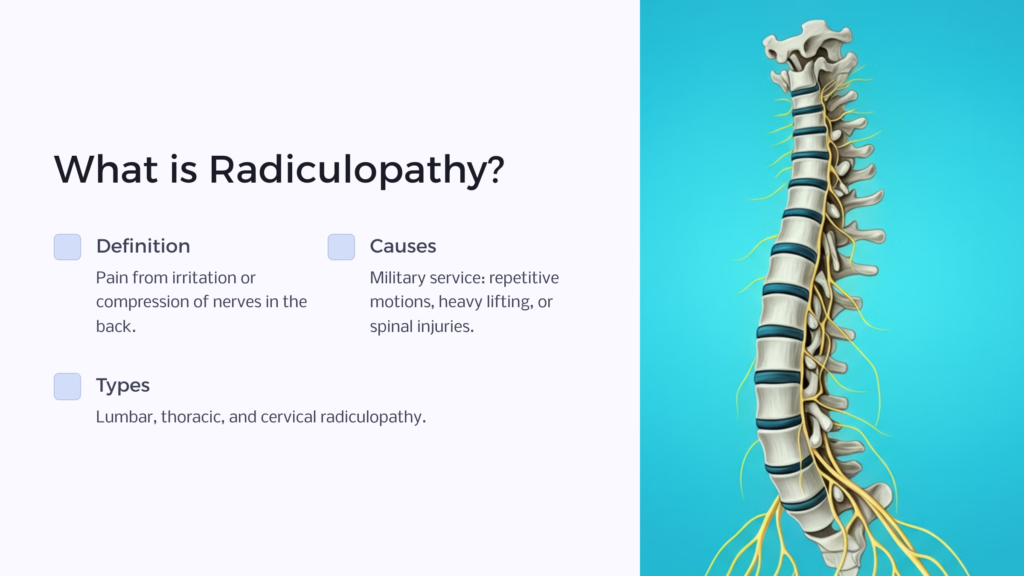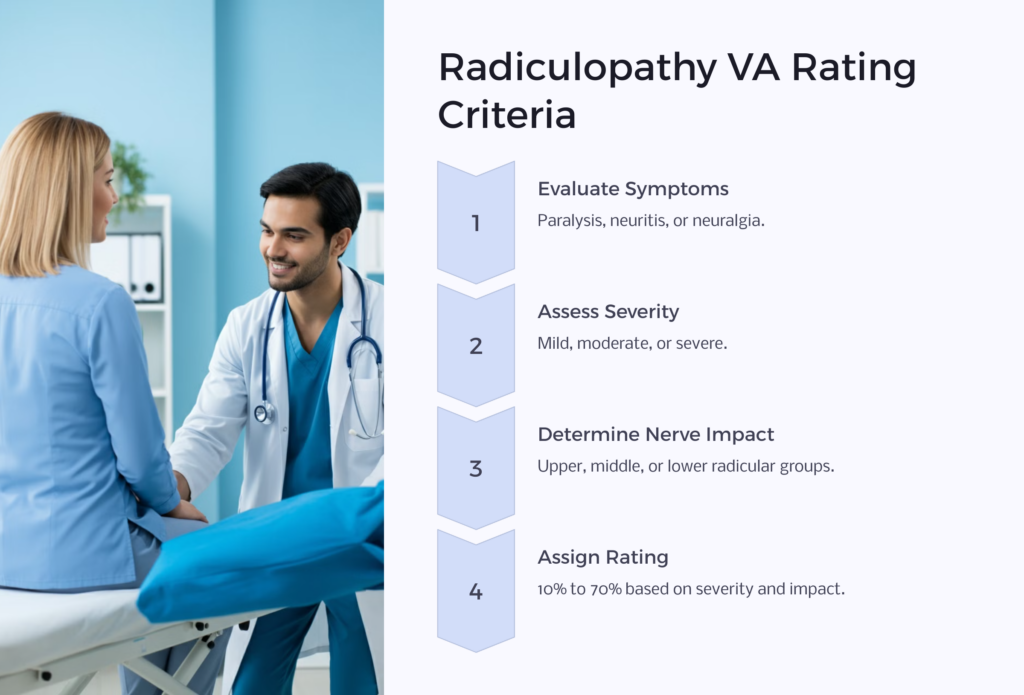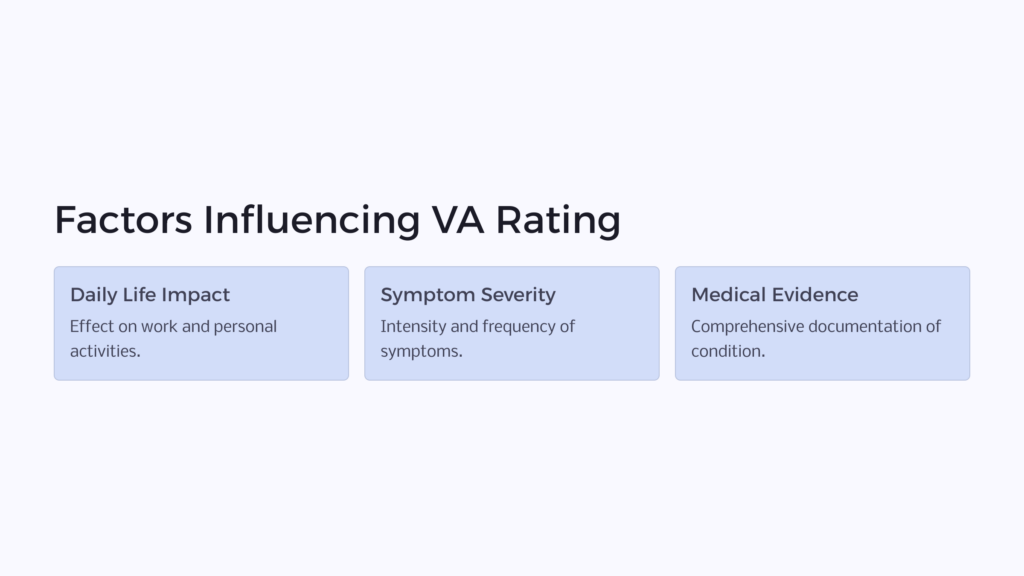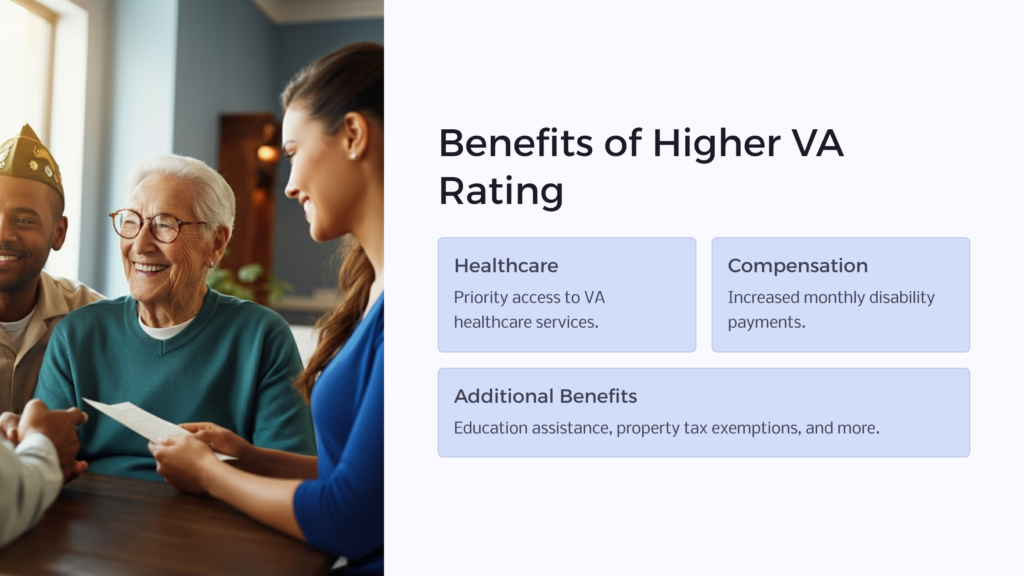Many veterans suffer from back problems and related symptoms. You may have been suffering from back injuries or related issues before you joined the military, but your condition worsened because of your military service. So, you now experience symptoms like numbness in your arms, hands, or legs, dull or sharp pain, or limited range of motion. The broad medical term the Department of Veterans Affairs (VA) uses for these types of conditions is “radiculopathy,” and many military veterans diagnosed with it are eligible for monthly financial compensation.
The VA uses specific criteria and codes from the Schedule for Rating Disabilities to establish the severity of radiculopathy symptoms. The unique symptoms a military veteran experiences factor into the VA disability rating criteria, with disability ratings varying from 10% to 90% based on the severity and impact on movement. You must have a formal diagnosis of radiculopathy to qualify for service-related compensation.
Understanding Radiculopathy

Radiculopathy refers to the pain experienced due to irritation or compression of the nerves in the back.
You can imagine the nerves in your back like a highway, with messages driving to and from your brain. Here, radiculopathy is like debris or potholes in the lanes–road damage hinders messages from reaching their destinations. That causes many aversive symptoms depending on the nerve that’s affected.
Several factors related to military service can cause this condition, including repetitive motions, heavy lifting, or spinal injuries from combat-related activities or military tasks. All these factors cause radiculopathy, often via bone spurs, degenerative disc disease, bulging discs, disc herniation, natural wear and tear, or spinal stenosis.
The spine has three primary sections: lumbar (lower back), thoracic (mid back), and cervical (upper back). Similarly, there are three kinds of radiculopathy, named depending on the section of the spine where the damaged nerves are found–lumbar radiculopathy, thoracic radiculopathy, and cervical radiculopathy.
Symptoms of radiculopathy often depend on the location of the damaged nerves in the back. Common symptoms include weakness, sharp pain, and numbness, which vary from debilitating to mild discomfort based on the severity of nerve damage.
If nerves in your lower back are affected, you may experience numbness or pain in your leg. If nerves in your neck are involved, you may feel tingling or pain in your arms. Some military veterans suffering from this medical condition have recurring symptoms, whereas others might experience occasional flare-ups.
Lumbar radiculopathy, also known as sciatica, affects nerves in the lower back. This is the most common service-related disability among military veterans, and it’s the most common type of radiculopathy.
The nerve damage in the lower back occurs when discs in the lumbar spine degenerate or herniate, exerting pressure on the nerves. Military veterans with this type of radiculopathy experience tingling, numbness, or pain that radiates from the lower spine down to the legs following the sciatica nerve path.
Cervical radiculopathy often occurs when nerves in the neck are irritated or compressed, causing symptoms that radiate down the arms and hands. Common symptoms include numbness, tingling, weakness, and decreased motor skills.
On the other hand, thoracic radiculopathy is the least common form of radiculopathy. It affects the nerves in the upper spine. Military veterans suffering from this condition might experience tingling, numbness, or pain in the front body, including the chest, ribcage, or abdomen.
The VA Rating System
This is a percentage-based system that determines the severity of a veteran’s service-connected condition and, consequently, their financial compensation. The rating system recognizes and compensates veterans for injuries or illnesses that occurred or worsened because of their military service. It operates on a percentage basis, ranging from 0% to 100%, with higher percentages demonstrating increased severity of a veteran’s condition and its effects on their ability to function normally.
The system is vital because it directly pertains to service-related disabilities, linking them to a rating that translates into monthly benefits.
Understanding the VA Disability Rating System is vital for military veterans, as it directly affects benefits like compensation, healthcare coverage, employment services, and education opportunities.
When determining your disability rating, the VA considers these factors:
- The severity of your medical condition
- Effect on your ability to perform everyday activities and work
- The supporting documentation
The assigned VA rating signifies the level of disability, with higher percentages indicating severe disabilities and potentially more compensation.
The VA has created a Schedule of Rating Disabilities (VARSD) to assign a percentage rating to each disability. The ratings depend on the average impact each disabling condition has on veterans’ earning capacity. These ratings range from 0% to 100% in 10% increments.
Radiculopathy VA Rating In-Depth

The VA uses different codes to rate radiculopathy, depending on the nerves affected and their functionality levels. Typically, the VA determines the severity of radiculopathy symptoms by first evaluating if a military veteran suffers from the following:
- Paralysis: In this case, the nerves can’t function via partial or complete paralysis.
- Neuritis: Here, the nerve groups still function but are irritated, painful, or swollen. Neuritis requires at least one of these critical things: reflex loss, reduced senses, or muscle atrophy.
- Neuralgia: The nerve causes occasional or constant pain characterized by tingling or numbness.
However, in most cases, symptoms overlap, and assessments of neuralgia, neuritis, and paralysis can be inconsistent and confusing.
The VA then rates radiculopathy based on severity, functioning levels, and the impacted nerve or nerve group. Thus, each nerve group has a different rating for different severity levels.
- Cervical radiculopathy: Military veterans with this type of radiculopathy are rated within the lower, middle, and upper radicular groups, which comprise the median nerve, musculospiral nerve, musculocutaneous nerve, ulnar nerve, long thoracic nerve, and axillary nerve. The VA rates the upper radicular nerves under diagnostic codes 8510, 8610, and 8710.
- Lumbar radiculopathy or sciatica: Veterans with this condition are rated within peripheral nerves of the lower back and legs. This type of radiculopathy commonly affects the sciatic nerve. The VA rates sciatic nerve under diagnostic codes 8520, 8620, and 8720.
If a military veteran has factual symptoms that can be diagnosed through testing, they’ll receive a moderate rating. This rating changes depending on the specific nerve.
Most military veterans with mild cases, resulting in sensory symptoms like tingling, receive a disability rating of 10% to 20%. Those with moderate cases of radiculopathy receive a disability rating between 20 and 40%. Moderate cases involve severe sensory symptoms like numbness, tingling, and impaired movement.
Severe cases of radiculopathy involve significantly impaired motion and are rated up to 50%. Military veterans with complete paralysis receive a disability rating that falls between 60 and 70%. This involves radiculopathy cases that prevent or severely hinder movement in the affected nerve regions.
The degree to which your movement is affected determines the disability rating the VA assigns to your symptoms.
If the nerve condition impairs both sides of your body, including arms and legs, the VA assigns a disability rating for both sides and an additional bilateral factor. The VA then combines ratings for the right and left sides and adds 10%. This factor considers the limitations disabled veterans face and how their condition affects their daily lives.
Further, veterans with VA ratings of less than 100% who can’t work because of their condition can seek additional compensation under the Total Disability Individual Unemployability (TDIU) program. Military veterans eligible for TDIU receive the same compensation a 100% rating would provide.
To qualify, you must have one disabling condition rated at least 60% or multiple disabilities with a combined disability rating of at least 70% with one condition rated 40% or more.
Factors Influencing the Radiculopathy VA Rating

The VA considers several factors when assigning a VA rating for radiculopathy, including:
- Impact of radiculopathy on daily life and work. Living with radiculopathy can be daunting. It can affect every part of your everyday life, from your personal relationships to your ability to work. The VA considers this when determining your disability score. They want to understand how your condition affects your ability to function. Thus, they consider factors like ability to work, limitations in mobility, and overall quality of life. Providing comprehensive evidence about the practical implications of your radiculopathy in your life is pivotal in getting an accurate disability rating. The goal is to give a vivid picture of your life with radiculopathy.
- The severity of your symptoms. Conveying the seriousness of your radiculopathy symptoms to the VA can be daunting. You don’t just need to describe your symptoms. You need to explain how those symptoms affect your daily life. The best way to do that is to keep a health journal. This will help you monitor your symptoms and their effect on your daily activities. Also, you can include statements from those close to you. These people can offer firsthand accounts of how your condition affects you. Don’t forget that the more accurate and detailed your description is, the more likely the VA will assign you a higher disability rating. This can help you secure the disability benefits you deserve.
- Medical Evidence. Medical evidence and documentation are critical in securing an accurate VA disability rating. The VA uses medical evidence to ascertain if your disability is service-related. Medical reports are vital pieces of evidence. They provide a clear picture of your health condition and the progression of your radiculopathy. Also, service records are essential. They can prove your military service caused or worsened your disability. When assigning a disability rating, the VA also considers statements from family, friends, and coworkers. These can help you prove how your radiculopathy affects your daily life, and ultimately, you receive a high disability rating, which can help you secure the compensation you deserve.
Process of Applying for a Radiculopathy VA Rating
The process of applying for a VA disability rating for radiculopathy starts with filing a disability claim, which includes a C&P (compensation & pension) examination and a detailed review of medical evidence.
The Department of Veterans Affairs will schedule a C&P examination to gauge the severity of your nerve damage as part of the claims process. Attending the examination and providing accurate information about your condition, and limitations is crucial in determining your VA disability rating. Be ready to explain how radiculopathy affects your everyday life and any limitations you face. The exam results will be considered in determining your VA disability rating for radiculopathy.
Comprehensive medical records are crucial in proving your claim for long-term disability benefits for radiculopathy. These records serve as the foundation for your claim and give the VA a vivid picture of your condition. Examples of medical evidence that can help you get an accurate rating for radiculopathy include:
- MRIs. They provide detailed images of your spine, including nerve roots, spinal discs, and any possible causes of irritation or compression.
- CT scans are pivotal in visualizing the bony structures of your spine and can identify medical conditions like spondylolisthesis.
- X-rays that show the alignment of your vertebrae and any structural defects, like deformities or fractures.
- Electromyography results that evaluate the electrical activity of muscles.
- Your doctor can also order blood tests to rule out underlying systemic medical conditions that may be contributing to radiculopathy symptoms, like inflammatory disorders or infections.
- Medical notes from your doctors.
- Narrative letters from your doctors that describe the magnitude of your symptoms, their effect on your ability to work, and recommended accommodations or treatments.
Further, to get an accurate rating for radiculopathy and get the benefits you deserve, you’ll need to prove your condition is service-related. You must show a current medical diagnosis of radiculopathy that’s linked to an in-service incident that aggravated or caused your condition. Examples of in-service incidents include:
- Operating a weapon
- Jumping
- Suffering physical back strain or dislocating or breaking a vertebrae while training
- Lifting equipment
- Completing other military activities
Military veterans don’t necessarily have to trace their radiculopathy to any specific active-duty incident.
Impact of Radiculopathy VA rating on life quality

A high VA rating for radiculopathy can offer various benefits, including access to better healthcare services, greater monthly compensation, and eligibility for other financial payments like adaptations for disability-friendly housing and travel reimbursements.
Also, a high radiculopathy rating can significantly affect one’s quality of life, especially if it allows them to access better healthcare and other provisions pivotal in managing their condition. Military veterans with high disability ratings also receive priority access to healthcare services offered by the VA. That means you can receive treatment for radiculopathy faster and more efficiently. Further, veterans with a 90% VA disability rating for radiculopathy are eligible for free healthcare services via the VA. This is pivotal for military veterans with significant medical needs.
Military veterans can appeal their disability rating if they feel it doesn’t accurately represent the severity of their condition. Understanding the VA disability appeal can help you get a higher radiculopathy rating, which can help you secure additional benefits like educational assistance and property tax exemptions.
Conclusion: Radiculopathy VA Disability Rating
Radiculopathy is caused by dysfunction or damage to nerves near the spine. Its symptoms include neck pain, general pain, tingling, numbness, and complete or partial paralysis. It’s crucial for military veterans with this condition because of military service to understand how the VA offers assistance through disability benefits via the disability rating system.
The VA assigns disability ratings for radiculopathy using specific diagnostic codes depending on the affected nerve groups–thoracic, lumbar, or cervical–with symptoms and effects on movement determining the rating percentage. You can increase your VA radiculopathy rating by providing elaborate medical evidence and documents describing the impact on daily life and firmly explaining how your disability limits you from engaging in daily activities, like walking for prolonged periods or even working.
 Benefits.com Advisors
Benefits.com Advisors
With expertise spanning local, state, and federal benefit programs, our team is dedicated to guiding individuals towards the perfect program tailored to their unique circumstances.
Rise to the top with Peak Benefits!
Join our Peak Benefits Newsletter for the latest news, resources, and offers on all things government benefits.


















